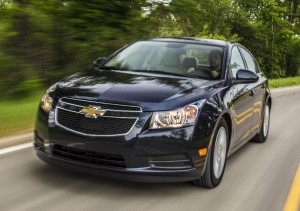A New Cruze
A New Cruze
GM reenters the passenger car light-diesel market after more than a 35-year absence.

- The 2014 Cruze diesel is taking aim at the VW Jetta TDI, and might be a real challenger.
Motor Age — It’s no secret that the U.S. fleet is totally at odds with it’s European counterpart in the mixture of diesel to gasoline powered cars and light trucks. And one has to wonder why diesel passenger cars are not as popular here as they are across the pond. After all, diesels are proven more efficient and more durable than their gasoline gobbling cousins, and significantly so. If in doubt, just ask Audi, the World Endurance champions for the past 15 years, running a diesel-powered car.
According to a recent poll sponsored by Audi, 59 percent of American drivers between the ages of 18 and 34 polled said they would buy a light diesel passenger car if the cost of diesel fuel were on par with gasoline. At the end of 2013, diesel fuel (even though it is cheaper to produce) cost almost 60 cents a gallon more. In addition to the disparity in fuel cost, diesel-equipped models carry a higher sticker price than the same model using a more traditional engine. It doesn’t take an MIT graduate to figure out that recouping the increased costs involved would take a long time, even with the more efficient powerplant.
In Europe, those factors are almost reversed. Cost of the initial purchase might be relatively equal, but the fuel costs are not. There, diesel fuel (dependent on country) can be significantly less than gasoline. Why? Taxation. Many European countries subsidize diesel fuel with lower tax rates, resulting in a lower pump price while the U.S. tax diesel more. Add in the increased fuel economy typically enjoyed by a diesel owner, and you can understand why diesels are the more popular choice.

The 2.0-liter powerplant is based on a proven platform, with more than half a million of them sold overseas. A few U.S. models, however, were in order to meet market needs.
German manufacturers want the American trend to change and have serious advertising campaigns in place to educate American consumers about the benefits of modern diesel ownership. In addition to the basic economics, these spots are showing how today’s diesels are also quieter and cleaner than the diesels of days past.
“The market for diesel cars in the U.S. is small at present,” says Mike Omotoso, powertrain analyst at LMC Automotive. “But it is expected to grow due to Corporate Average Fuel Economy (CAFE) requirements and expected increases in gas prices. So far, the German automakers haven’t had any real competition in North America.” Until now, as at least two of the Big Three announce plans to add diesels to their model lines.
GM Joins The Market
Many of our readers may recall GM’s dismal diesel forays back in the mid-1980s. The diesel Chevette and infamous Olds V-8s were well known for their failure rates. But the 2014 model year brings with it a new diesel offering, the Chevrolet Cruze. Not to be confused with its Suzuki cousin, the new Cruze started life as a globally developed platform back in 2008. It replaced the Chevy Cobalt in the North American market with its debut in the 2010 model year.
The North American version of the Cruze is built in GM’s Lordstown, Ohio, facility. Its 2.0-liter turbocharged diesel powerplant may be a new offering here, but it is hardly a new design. The basic architecture has been sold in Europe over the last 16 years under the Opel and Chevrolet nameplate and is assembled in Kaiserslautern, Germany. U.S. engineers worked with their European counterparts at GM’s Torino, Italy, design center to refine the design and insure it would meet or exceed all U.S. emissions standards.
Source: Motor Age

